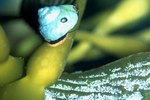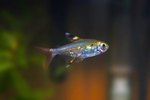
The plecostomus, known to aquarium hobbyists as the suckerfish or the algae-eater, is native to Central America and South America. In the wild, he can have a life span of more than 15 years and can grow to lengths of more than 2 feet. The mouth of the plecostomus is on the bottom of his head. His lips form a suction cup that allows him to attach to rocks, logs and other surfaces.
Aquarium
In captivity, a plecostomus doesn't reach his full potential. The plecostomus generally does not successfully breed in an aquarium, either. In captivity, the fish's life span is 10 to 15 years and his maximum size is about 18 inches. He will get along with most other species of fish with whom he shares a tank, though he can be territorial and aggressive with another plecostomus. While the plecostomus will feed on the algae in your tank, you may also want to supplement his diet with algae wafers.
Oddities
One of the odd aspects of the plecostomus' story is a superstition that surrounds his name. Many aquarium keepers won't say or write the full name of the fish because of a superstition that saying or writing the name will cause the fish to die. For this reason, the plecostomus is often simply called a pleco. The pleco's other name, suckerfish, can be seen in action when the fish attaches his mouth to the side of the aquarium and stays suspended for hours and even days. The plecostomus can store large amounts of air in his intestines. This enables him to survive in poor water conditions and out of water for as long as 30 hours.
Wild
The name plecostomus usually refers to all fish in the genus Hypostomus, which includes 138 species of suckerfish. Living in tropical freshwaters, the plecostomus is active after dark when he feeds on algae. When a pair are ready to mate, the male and female dig a cavity, where the female lays up to 300 eggs. The male guards the eggs until they hatch, four to 20 days later depending upon the particular species.
Invasive
In addition to his native territories, the plecostomus now lives wild in several states. The fish is considered an invasive species in these areas; he was likely introduced to U.S. waters by pet guardians who decided to free their fish or tried to get the fish to clean algae from bodies of water. The plecostomus has taken such a hold in some parts of Texas that breeding populations exist in at least four counties.
References
Photo Credits
-
Jupiterimages/BananaStock/Getty Images
Writer Bio
Bethney Foster is social justice coordinator for Mercy Junction ministry, where she edits the monthly publication "Holy Heretic." She is also an adoption coordinator with a pet rescue agency. Foster spent nearly two decades as a newspaper reporter/editor. She graduated from Campbellsville University, receiving a Bachelor of Arts in English, journalism and political science.




